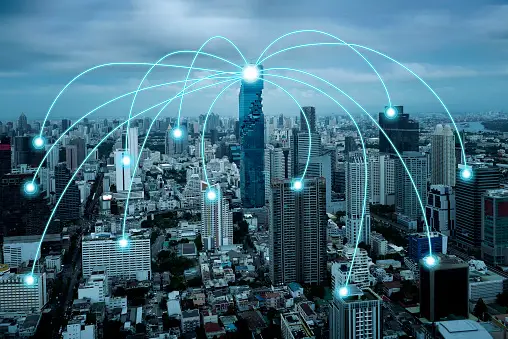AI revolutionizing telecom: intelligent networks, customer service, optimization through machine learning.
AI is Calling: Telecom Gets an Intelligent Makeover
Imagine a world where networks are self-healing, customer service is a delightful experience, and network optimization happens seamlessly, without human intervention. It may sound like science fiction, but this future is rapidly becoming a reality thanks to the game-changing power of Artificial Intelligence (AI) in telecommunications.
As the demand for faster, more reliable, and efficient connectivity continues to skyrocket, telecommunications companies are turning to AI as the secret sauce to revolutionize their operations. From proactive network management and predictive customer service to intelligent resource allocation and traffic optimization, AI is weaving its magic across the entire telecommunications landscape.
But what exactly is AI, and why is it such a big deal for the telecom industry? Let's dive in and uncover the fascinating world where machines mimic human intelligence, learn from data, and make decisions that would make even the savviest network engineers stand up and take notice.
## What is AI, and Why is it Important for Telecommunications?
AI refers to the ability of machines to mimic human intelligence, learn from data, and make intelligent decisions. It encompasses a wide range of technologies, including machine learning, natural language processing, computer vision, and robotics. In the telecommunications industry, AI has the potential to transform everything from network management and customer service to network optimization and predictive maintenance.
## How is AI Transforming Network Management?
### Proactive Network Monitoring and Maintenance
Traditional network management relies heavily on human intervention, which can be time-consuming and prone to errors. AI-powered systems, on the other hand, can continuously monitor network performance, identify potential issues, and take proactive measures to prevent outages or degradation of service.
By analyzing vast amounts of data from network devices and sensors, AI algorithms can detect anomalies, predict failures, and trigger automated maintenance processes. This proactive approach ensures that networks remain reliable and efficient, reducing downtime and minimizing the impact on customers.
### Self-Healing and Adaptive Networks
AI is paving the way for self-healing and adaptive networks that can automatically reconfigure themselves to optimize performance and respond to changing conditions. These intelligent networks can dynamically allocate resources, reroute traffic, and adjust settings based on real-time data analysis and machine learning models.
This adaptability ensures that networks can handle fluctuations in demand, network congestion, and other challenges without human intervention, leading to improved quality of service and enhanced user experiences.
## How is AI Revolutionizing Customer Service?
### Virtual Assistants and Chatbots
One of the most visible applications of AI in telecommunications is the use of virtual assistants and chatbots for customer service. These AI-powered systems can understand natural language, engage in conversational interactions, and provide personalized assistance to customers.
By leveraging natural language processing and machine learning, chatbots can handle a wide range of customer inquiries, from billing and technical support to product information and service activation. This not only improves the customer experience by providing 24/7 support but also reduces the workload on human customer service representatives, allowing them to focus on more complex issues.
### Predictive Customer Experience
AI algorithms can analyze vast amounts of customer data, including interaction histories, preferences, and behaviors, to predict their needs and tailor the customer experience accordingly. By anticipating customer requirements and proactively offering personalized solutions, telecommunications companies can enhance customer satisfaction and build stronger relationships.
This predictive approach can also help identify and address potential issues before they escalate, leading to improved customer retention and loyalty.
## How is AI Optimizing Telecommunications Networks?
### Network Capacity Planning and Resource Allocation
AI plays a crucial role in optimizing network capacity and resource allocation. By analyzing historical data and user patterns, AI algorithms can forecast future demand and intelligently allocate resources to ensure efficient network utilization.
This proactive approach helps telecommunications companies avoid over-provisioning or under-provisioning resources, resulting in cost savings and improved network performance.
### Traffic Management and Network Congestion Control
AI-powered traffic management systems can dynamically reroute network traffic based on real-time conditions, alleviating congestion and ensuring optimal data flow. These intelligent systems can analyze network patterns, identify bottlenecks, and implement load balancing strategies to distribute traffic across available resources.
By leveraging machine learning algorithms, these systems can continually adapt and optimize traffic management strategies, leading to improved network performance and reduced latency.
## What are the Challenges and Concerns Surrounding AI in Telecommunications?
### Data Security and Privacy
As AI systems rely heavily on data for training and decision-making, there are legitimate concerns around data security and privacy. Telecommunications companies must implement robust measures to protect sensitive customer information and ensure compliance with data protection regulations.
Additionally, AI models themselves can be vulnerable to adversarial attacks, where malicious inputs are designed to manipulate the model's output. Addressing these vulnerabilities is crucial to maintaining trust in AI-powered systems.
### Ethical Considerations
The deployment of AI in telecommunications raises ethical questions around transparency, accountability, and potential biases. AI systems must be designed and deployed in a responsible and ethical manner, ensuring fairness, privacy protection, and adherence to ethical principles.
Telecommunications companies must establish clear governance frameworks and guidelines to mitigate the risks associated with AI and ensure its responsible and ethical use.
### Workforce Transformation and Skill Development
The integration of AI in telecommunications will inevitably lead to changes in workforce needs and skill requirements. While AI may automate certain tasks, it will also create new job roles and demand for professionals with specialized skills in areas like data science, machine learning, and AI engineering.
Telecommunications companies must invest in reskilling and upskilling their workforce to adapt to these changing demands and ensure a smooth transition to an AI-powered future.
## What's Next? Envisioning the Future of AI in Telecommunications
As AI continues to evolve and mature, the telecommunications industry will witness even more transformative applications. From fully autonomous network management and self-optimizing networks to seamless human-machine collaboration in customer service, the possibilities are endless.
Moreover, the convergence of AI with other emerging technologies, such as 5G, Internet of Things (IoT), and edge computing, will open up new avenues for innovation and disruptive solutions.
However, to fully realize the potential of AI in telecommunications, ongoing research, collaboration, and collective efforts are crucial. Industry stakeholders, policymakers, and researchers must work together to address challenges, foster innovation, and ensure the responsible development and deployment of AI in the telecommunications sector.
In the ever-evolving digital landscape, one thing is certain: AI is poised to reshape the future of telecommunications, paving the way for smarter, more efficient, and customer-centric networks that will connect the world like never before.


.jpeg?locale=en)























